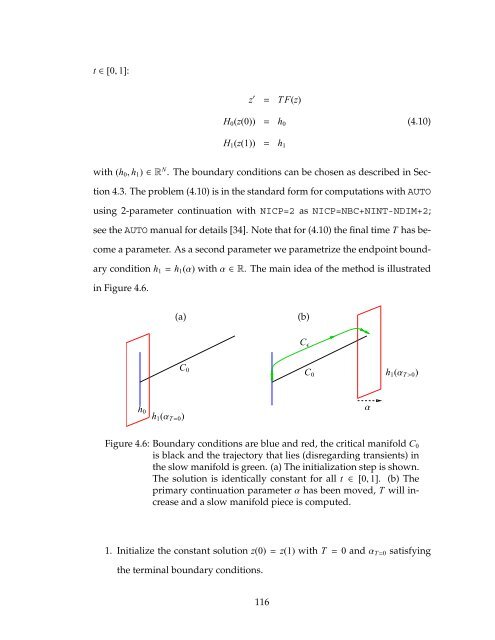multiple time scale dynamics with two fast variables and one slow ...
multiple time scale dynamics with two fast variables and one slow ...
multiple time scale dynamics with two fast variables and one slow ...
Create successful ePaper yourself
Turn your PDF publications into a flip-book with our unique Google optimized e-Paper software.
t∈[0, 1]:<br />
z ′ = T F(z)<br />
H0(z(0)) = h0 (4.10)<br />
H1(z(1)) = h1<br />
<strong>with</strong> (h0, h1)∈R N . The boundary conditions can be chosen as described in Sec-<br />
tion 4.3. The problem (4.10) is in the st<strong>and</strong>ard form for computations <strong>with</strong> AUTO<br />
using 2-parameter continuation <strong>with</strong> NICP=2 as NICP=NBC+NINT-NDIM+2;<br />
see the AUTO manual for details [34]. Note that for (4.10) the final <strong>time</strong> T has be-<br />
come a parameter. As a second parameter we parametrize the endpoint bound-<br />
ary condition h1= h1(α) <strong>with</strong>α∈R. The main idea of the method is illustrated<br />
in Figure 4.6.<br />
C0<br />
h0 h1(αT=0)<br />
(a) (b)<br />
Cǫ<br />
C0<br />
α<br />
h1(αT>0)<br />
Figure 4.6: Boundary conditions are blue <strong>and</strong> red, the critical manifold C0<br />
is black <strong>and</strong> the trajectory that lies (disregarding transients) in<br />
the <strong>slow</strong> manifold is green. (a) The initialization step is shown.<br />
The solution is identically constant for all t ∈ [0, 1]. (b) The<br />
primary continuation parameterαhas been moved, T will increase<br />
<strong>and</strong> a <strong>slow</strong> manifold piece is computed.<br />
1. Initialize the constant solution z(0)=z(1) <strong>with</strong> T = 0 <strong>and</strong>αT=0 satisfying<br />
the terminal boundary conditions.<br />
116
















